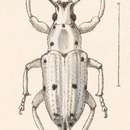Description
provided by INOTAXA archive
Elongate, black, densely clothed (the punctures included) with chalky-white scales, the elytra each with three or four small bare black spots—one on the fourth or fifth interstice below the base (sometimes obsolete), one at the middle of the disc, one in a line with it on the outer margin, and one on the third interstice towards the apex,—the prothorax also sometimes with three or five small black spots (three on the anterior margin and one on each side of the disc towards the base). Rostrum hollowed and obsoletely sulcate anteriorly, the upper portion obliquely divergent on each side in front, the scrobes descending for a short distance before the eyes, the latter rounded and convex; antennal scape reaching to a little beyond the eyes. Prothorax transverse, deeply bisinuate at the base, slightly rounded at the sides, broadly flattened or hollowed down the middle. Elytra elongate-triangular, flattened on the disc, lobed at the base, acuminate at the apex, the apices dentiform; with rows of fine, subapproximate punctures placed in very shallow foveæ, the third interstice gradually becoming more raised to the apical declivity and then abruptly declivous, the fifth also raised posteriorly and the seventh anteriorly.
Length 12—15, breadth 4 1/10—5½ millim. (?♀.)BIOL. CENTR.-AMER., Coleopt., Vol. IV. Pt. 3, October 1911. 2 PP
- license
- cc-by-3.0
- copyright
- Biologia Centrali-Americana
Distribution
provided by INOTAXA archive
Hab.GUATEMALA? (Scherzer, in Mus. Brit.); COSTA RICA, Piedras Negras (U. S. Nat. Mus.); PANAMA, Chiriqui (Trötsch).
- license
- cc-by-3.0
- copyright
- Biologia Centrali-Americana
Physical description
provided by INOTAXA archive
Three specimens, varying in the number of the spots on the prothorax and elytra, the individual from Chiriqui having the prothorax almost immaculate. The third elytral interstice becomes more prominent and cariniform posteriorly, but it is not tuberculate at the commencement of the apical declivity as in C. cretaceus (F.) and some other allied S.-American forms. The seriate punctures are closely placed, fine, and shallow, and the sutural region is flattened. The minute scattered hair-like scales are just traceable. C. quadrisignatus and C. bisignatus, Boh., are somewhat similarly maculate.
- license
- cc-by-3.0
- copyright
- Biologia Centrali-Americana

